Lea este artículo en español.
California produces millions of tons of hazardous waste every year – toxic detritus that can leach into groundwater or blow into the air. It’s waste that can explode, spark fires, eat through metal containers, destroy ecosystems and sicken people. It’s dangerous material that we have come to rely on and ignore – the flammable liquids used to cleanse metal parts before painting, the lead and acid in old car batteries, even the shampoos that can kill fish.
It all needs to go somewhere.
But over the past four decades, California’s facilities to manage hazardous waste have dwindled. What’s left is a tattered system of older sites with a troubling history of safety violations and polluted soil and groundwater, a CalMatters investigation has found. Many are operating on expired permits. And most are located in communities of color, often ones with high rates of poverty, despite environmental justice laws meant to ensure that the most disadvantaged don’t also face the greatest pollution exposure.
“It’s difficult to permit a new toxic facility. There’s going to be a lot of resistance to building a new one,” said Bill Magavern, the Coalition for Clean Air’s policy director, who advised on a state report in 2013 that examined California’s hazardous waste permitting process. “So the path of least resistance is keeping some of the old ones going.”
This conflict is playing out in Santa Fe Springs, a city of about 19,000 people in Los Angeles County that houses one of the state’s biggest hazardous waste treatment and recycling facilities, called Phibro-Tech. Last year, state regulators issued a draft of a new five-year permit for the company, which has been running on an expired one since 1996. Community activists and environmental groups are opposed.
Phibro-Tech is one of only 72 permitted destinations for hazardous waste in a state that had more than 400 in the early 1980s. Shipping records show it handles as much as 23,000 tons of hazardous waste a year from some of the biggest West Coast companies, including tech giants Intel and TTM Technologies.
But Phibro-Tech is also a company with a lengthy record of violating laws meant to protect workers, the environment and its neighbors in a low-income Latino community, according to hundreds of pages of inspection reports CalMatters obtained through government databases and public records requests.
In recent years, California’s Department of Toxic Substances Control inspectors cited Phibro-Tech for leaking containers and cracked containment barriers. They identified poorly maintained wells that might allow toxic waste to seep into the environment and they dinged the company for failing to address one area of contamination on the site in a timely manner.
Among the pollutants state regulators have documented in soil and groundwater under and near the plant are trichloroethylene and hexavalent chromium – the cancer-causing chemical made famous in the movie “Erin Brockovich”.
Other regulators also found problems in the past decade. The Los Angeles basin’s air pollution agency cited the company after its equipment released ammonia gas, which can burn lungs if inhaled. Sanitation system regulators cited the company for discharging wastewater with excess contaminants into sewers, including copper, a hazardous element that can be toxic to aquatic life.
And occupational safety regulators cited the company for unsafe working conditions. Among the more serious incidents: In 2015, a worker making $15.70 an hour slipped in a puddle of spilled acid and got second- and third-degree burns on his legs, feet and genitals, workers’ compensation case file records and inspection reports show. Last year a cracked valve sprayed hydrochloric acid in another worker’s face, leaving him with breathing problems, those documents reveal.
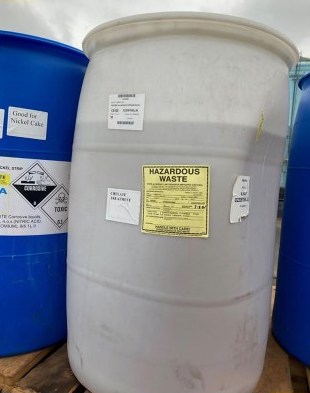
A white 55-gallon contracted drum stored corrosive liquid at Phibro-Tech Inc. on Sept. 27, 2021. Photo by Beatris Karaoglanyan, Department of Toxic Substances Control 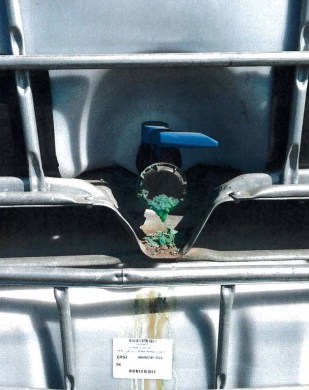
Inspectors documented a leaking container at Phibro-Tech Inc.on Sept. 4, 2019. Photo by Bailey Franklin, Department of Toxic Substances Control 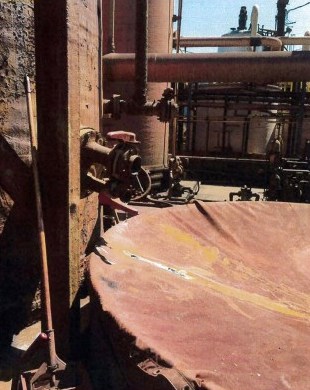
A valve leaked on a tank at Phibro-Tech Inc. on Sept. 4, 2019. Photo by Bailey Franklin, Department of Toxic Substances Control
The company’s representatives, in meetings with CalMatters, defended Phibro-Tech’s record. They want the state to approve a new operating document and blamed many of their regulatory violations on what they deem to be an ambiguous and outdated permit. The company has entered into agreements to fix problems found during inspections, and has addressed issues on site. They said residents are in no danger from operations and that contamination on site was from other companies – the legacy of a century of industrial operations there and nearby. And they touted Phibro-Tech’s role in recycling waste that would otherwise be dumped and lead to environmental damage from mining. (Every 55 pounds of copper the company is able to recover from the waste that electronics manufacturers send them is 10,000 pounds of earth that doesn’t need to be excavated in the hunt for precious metals, they said.)
But that’s little comfort to some residents of Los Nietos, in unincorporated Los Angeles County, where the nearest home is roughly 550 feet from Phibro-Tech’s warren of aging tanks and labyrinthine pipes. It’s one of the most environmentally vulnerable areas in California, according to a complicated scoring system the state devised to account for exposure to pollution and health risk because of factors such as poverty.
More than 20 sites generating hazardous waste sit within a mile of this neighborhood, including companies that do chrome plating, manufacture radiators and make batteries.
“We are not a rich people,” said Esther Rojo, whose house is a thousand feet – as the wind blows – from Phibro-Tech. “So they put all of them over here in this area.”
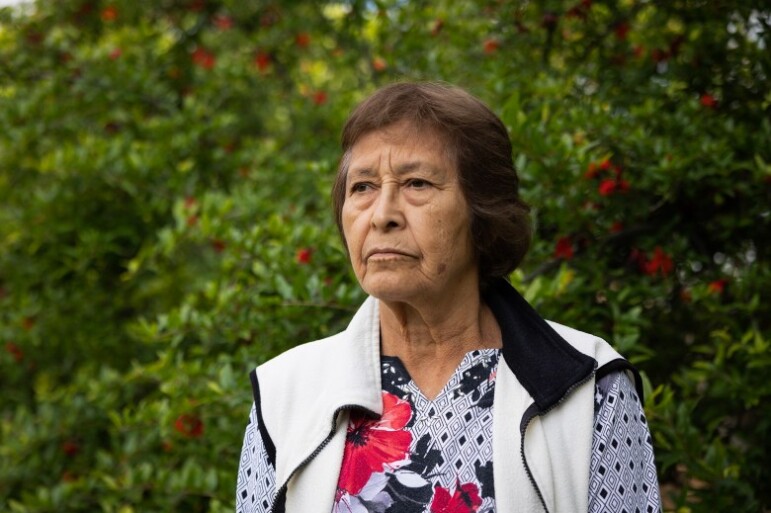
A 2015 state law was supposed to do something about that — by requiring regulators to consider the “cumulative impact” on communities when making permitting decisions. Yet officials never actually adopted the regulations that the law required. The Department of Toxic Substances Control – which refused to be interviewed for this story – is poised to finalize the draft permit for Phibro-Tech later this year.
“We don’t know what to do,” Rojo said. “(Phibro-Tech) got the money. They got the power to stay here.”
The rules for handling dangerous waste date back to the 1970s, when state and federal officials began trying to define “hazardous.” That’s when they passed laws and started crafting regulations branding certain material with the label based on characteristics including ignitability (would it burst into flames?), corrosivity (could it eat through a metal container?), toxicity (are you more likely to get cancer if you’re exposed to it?) and reactivity (is it unstable and likely to explode?).
Those regulations generally require that hazardous waste go to a specially permitted facility that can treat, store or dispose of the material. But while just about everyone wants consumer products that lead to the creation of hazardous waste, no one wants that waste dumped in their backyard.
In the past 40 years, the number of California facilities that have permits to treat, store or dispose of hazardous waste has dropped by more than 80% — while the number of places that generate this waste grew by more than 70% since 2010, according to a state report released last month. Only 72 permitted facilities remain statewide to handle the waste of about 94,500 generators. As some companies turn to more sustainable practices, California’s volumes of hazardous waste have dropped a modest amount since the 1990’s, state analyses of shipping records show. For example, California shipped about 11% less hazardous waste in 2015 than it did in 1995.
Officials and experts have long recognized that there’s little political will to open new sites to take toxic material. A 2017 state report discussed California’s longstanding efforts to reduce the generation of hazardous waste because of the “difficulty in gaining consensus in the siting of new facilities.”
It’s also expensive to try to open a new site. Permitting can take years and can cost hundreds of thousands of dollars for companies who also “must pay taxes and any other expenses to maintain the property throughout time the permit is being processed, despite receiving no revenue from the facility,” according to the July report.
Perhaps unsurprisingly then, roughly half the hazardous waste generated in California winds up in other states – often ones with weaker environmental regulations, according to a Department of Toxic Substances Control analysis of shipping records. (California’s standards are tougher than the federal ones. So waste considered hazardous in California can sometimes be disposed of at regular landfills in states like Arizona and Utah.) The average distance from a California hazardous waste generator to a destination facility is 500 miles, according to the July report.
CalMatters asked the Department of Toxic Substances Control when it last received a permit application from a company trying to open a business in California to store, treat or dispose of federally defined hazardous waste. “Based on a review of available information,” there doesn’t appear to have been any permit applications for a new commercial facility since the early 1980s, according to the agency.
The toxic material that stays in California goes to a relatively small collection of aging facilities, many of which have a history of regulatory violations and safety lapses, a CalMatters review of permitting and enforcement records found.
Using a list of permitted hazardous waste businesses in California and a database of shipping records, CalMatters identified 41 commercial facilities in California that received at least one shipment of hazardous waste last year. (The rest are largely a mix of military installations and operations that treat their own toxic waste before sending it to another facility, records show.) Among those 41 sites, 24 have been the subject of “corrective action” to clean contamination on their site (some tracing back to earlier owners), 29 were the subject of enforcement action by toxics regulators since 2010, and 11 are operating on expired permits.

“It can’t be that a system that’s held together at best by bubble gum and baling wire is the thing that we’re doing in a developed nation to manage hazardous waste,” said Angela Johnson Meszaros, a managing attorney with the environmental law organization Earthjustice.
State and federal law allows hazardous waste facilities to operate on an expired permit so long as they’re working to get a new one. Companies need to apply six months before the expiration date. But it takes years to process a permit. A recent state law changed that timeline and beginning in 2025 companies will need to apply two years before the expiration date. Still, that’s not always enough time to get it done.
Phibro-Tech’s permit expired in 1996 – making it the oldest so-called “continued permit” in California, state records show.
Johnson Meszaros said outdated operating documents are a safety concern and need to be overhauled “because we understand that you have to go back and look and change permits to address changes to the world around a facility.”
The reasons experts give for the permitting delays are myriad. Complicated and highly technical decisions are being made by a state department that’s long struggled with staffing and turnover, interviews with former agency employees and industry insiders, and a state report on the issue suggest. The process also can require extensive public engagement including open meetings and formal comment periods.
And environmental activists question how motivated companies are to speed the process when they can keep operating without a current permit.
Some advocates and former agency employees also say the Department of Toxic Substances Control tends to push off tough decisions. Regulators can be hesitant to deny a permit because the state needs to have a place to send its hazardous waste.
“For too much of its history (the department) bent over backward to keep facilities open even when they should have been shut down,” said Bill Magavern, who advised on a state commissioned review of the agency’s permitting process a decade ago.
In a prepared statement the department said it “does not take into consideration the state’s hazardous waste capacity when reviewing permit applications.”
“Decisions are based on the facility’s compliance with laws and regulations, and whether operations can be conducted in a manner that is protective of public health and the environment,” the statement said.
The toxics department did deny an updated hazardous waste permit in 2020 to General Environmental Management in Rancho Cordova. It was one of four permit renewals the agency denied since 2010 but the only rejection for a commercial facility authorized to take federally defined hazardous waste, state records show. The company argued in court filings that it didn’t deserve such an “unprecedented administrative decision,” and that its services were “particularly important to California’s safe and effective management of hazardous waste” because there were so few permitted commercial sites left in the state. The facility had been the site of three fires and an explosion since 2011 due to mismanagement, regulators alleged in their own legal filings.
“When your thing is literally on fire, even (the Department of Toxic Substances Control) has to acknowledge it,” said Johnson Meszaros, the Earthjustice attorney.
Phibro-tech’s troubled record
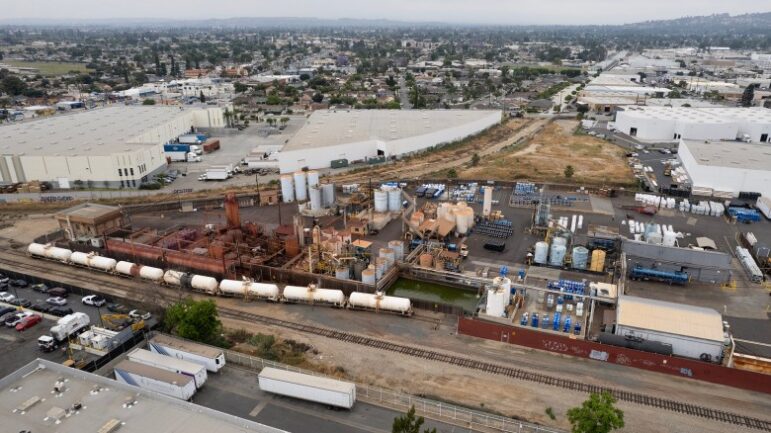
Phibro-Tech sits on a 4.8 acre triangle of land just inside the border of Santa Fe Springs.
The site’s industrial roots stretch back to the 1920s. It was a railroad switching station, a foundry and a chemical company before Phibro-Tech’s operations started in 1984. (The company, whose parent corporation is headquartered in New Jersey, had a different name but the fundamental control has been the same since 1984, Phibro-Tech’s attorney said.)
The company’s specialty is recycling the corrosive liquids that electronics manufacturers use to etch patterns on the surface of microchips and circuit boards. Company representatives say it’s the only site west of the Mississippi that recycles so-called “spent etchants.”
The company separates out the metals and cleans the liquid – selling the treated etching solution back to the tech industry and making copper products for manufacturers.
“If not for Phibro-Tech, the California electronics industry would need to send all of its spent etch to landfills or deep wells at a significant cost to the environment, or ship it across country, making the industry less competitive,” according to a letter from the electronics manufacturing trade group IPC to state regulators in 2017.
Phibro-Tech also takes giant bags of rust from steel mills and old metal cans from canneries and uses them to make ferric and ferrous chloride – which are used to clean drinking water and control odor at wastewater treatment plants. It recovers metals such as nickel from liquid waste and sends it to smelters. And it treats brine from water treatment operations contaminated with hexavalent chromium. Some of its operations use raw materials and aren’t regulated under the hazardous waste permit.
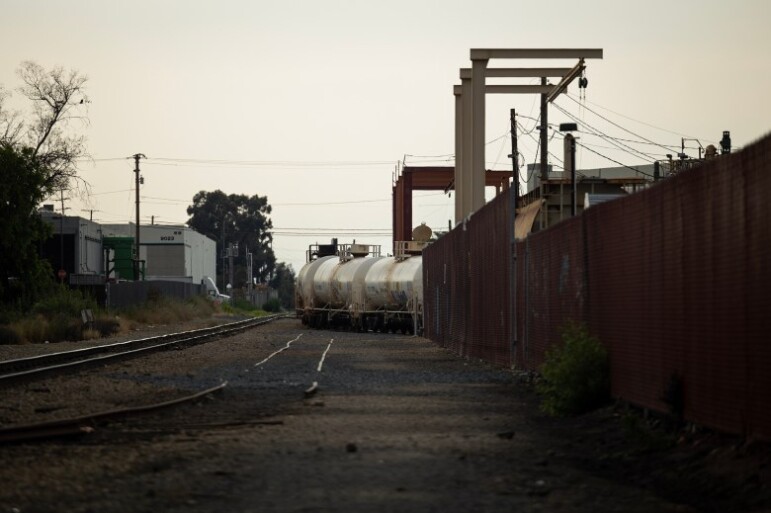
A train line leads to the Phibro-Tech Inc. plant in Santa Fe Springs on June 7, 2023. 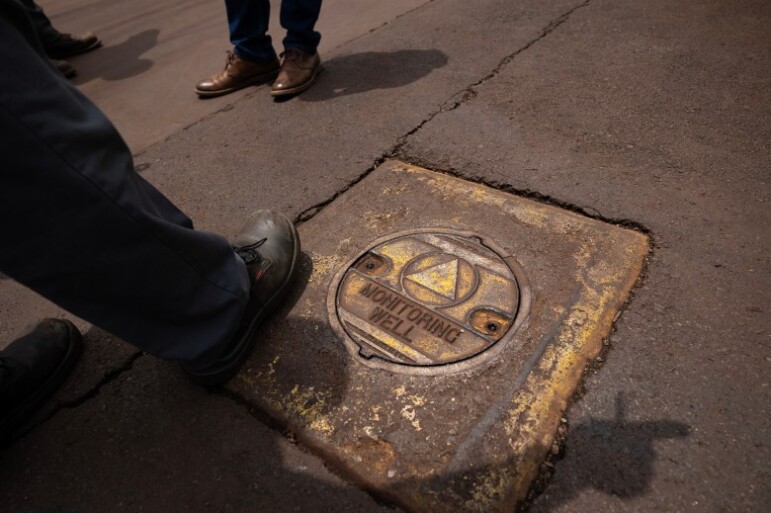
A groundwater monitoring well at Phibro-Tech Inc. in Santa Fe Spring on June 8, 2023.
The California Water Service Company, a large investor-owned utility, told regulators in a letter that Phibro-Tech was a “vital service” provider.
But records show decades of problems at the site. The Department of Toxic Substances Control’s online permitting and enforcement database shows the agency’s inspectors have identified violations at 32 different inspections since 1996. In 19 of those inspections the company was cited for so-called “Class 1” violations – the most serious designation suggesting a significant threat to people or the environment.
Some of the violations were repeated through the years despite the company’s promises to change its behavior. In 1999 it committed to stop storing hazardous waste in unauthorized areas and yet inspectors found that “for at least 167 days following Respondent’s execution of the 1999 Consent Order, beginning within a week of that date, Respondent continuously stored hazardous waste outside permitted storage areas,” according to a 2003 consent order.
Enforcement records show regulators found waste stored in unauthorized areas again in 2005, 2008, 2011 and 2015.
“Phibro-Tech takes compliance very seriously,” said David Thaete, the facility’s environmental health and safety manager.
In a meeting with Phibro-Tech’s attorney, plant manager and Thaete as well as written responses to questions, company officials blamed some agency violations on ambiguities in the old permit and seemingly arbitrary or shifting enforcement.
For example, they pointed out that toxics regulators have known for years the site was treating material in certain equipment not permitted for handling hazardous waste and yet decades passed before regulators issued citations for some of those longstanding practices. (After inspectors cited the company in 2012 for operating one particular tank without a permit, the company got the tank – which had been in operation for years – permitted “and it now operates pursuant to the same procedures as before,” according to an email from the company’s attorney.)
Phibro-Tech representatives noted that after the company disputed certain violations, state officials reduced the severity of some and eliminated others from a scoring system the department created to hold troubled companies accountable. The reps also said the company has had fewer violations in recent years.

An air quality monitor on a fence line at Phibro-Tech Inc. in Santa Fe Spring on June 8, 2023. Photos by Miguel Gutierrez Jr., CalMatters 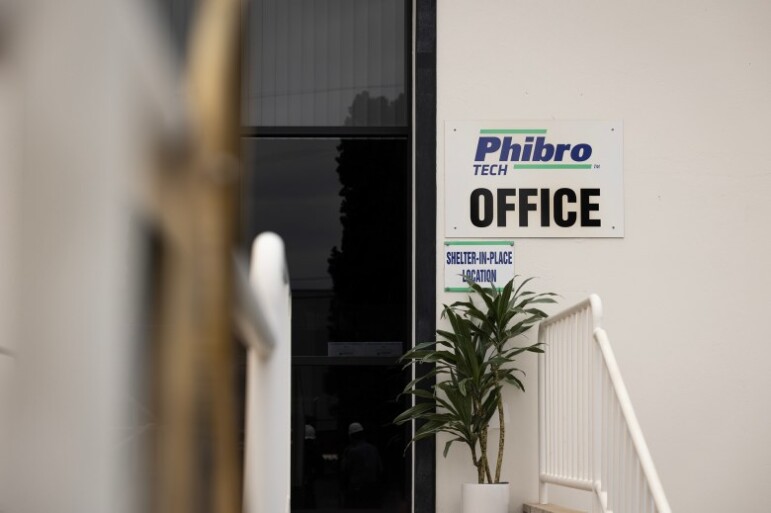
An air quality monitor on a fence line at Phibro-Tech Inc. in Santa Fe Spring on June 8, 2023. Photos by Miguel Gutierrez Jr., CalMatters
As for storing waste in unauthorized areas, a written statement from the company called the 1999 violation “a unique situation” when a competitor closed and Phibro-Tech suddenly got an influx of waste that exceeded its permitted storage capacity.
The later violations “can be considered to be ‘repeat violations’ only based on a very general characterization of storing hazardous waste in an unpermitted area, but the underlying facts do not compare,” according to the company.
It’s not just state toxics regulators who have found problems.
The Los Angeles County Sanitation Districts identified 17 violations since 2015 including instances where Phibro-Tech’s wastewater had excess contaminants such as copper, and oil and grease, according to documents CalMatters obtained through a public records request. Most resulted in just a verbal warning and CalMatters found no evidence that the wastewater — which is treated before it’s released into the ocean — harmed the environment. In February, Phibro-Tech discharged nearly 7,300 gallons of wastewater with a copper concentration nearly 14 times the permitted limit, according to inspection reports. The sanitation districts didn’t issue a notice of violation for that release, which the company blamed on operator error. State toxics regulators did issue a citation.
Cal/OSHA, the agency that enforces workplace safety regulations, identified 13 violations in four inspections since 2015, its records show, though none of those violations were deemed “serious” – those that could cause a death, illness or serious injury and that the employer could have known about.
The company’s rate of worker injuries and illnesses has been worse than the industry average in recent years – more than double the average rate for hazardous waste treatment and disposal sites in 2019 – although it “has been trending downward,” according to an outside audit of Phibro-Tech that regulators required the company to file.
The company says it “takes occupational safety seriously,” rigorously trains workers and makes changes as necessary to keep them safe.
While workers can choose to leave the company, many residents nearby don’t have that choice.
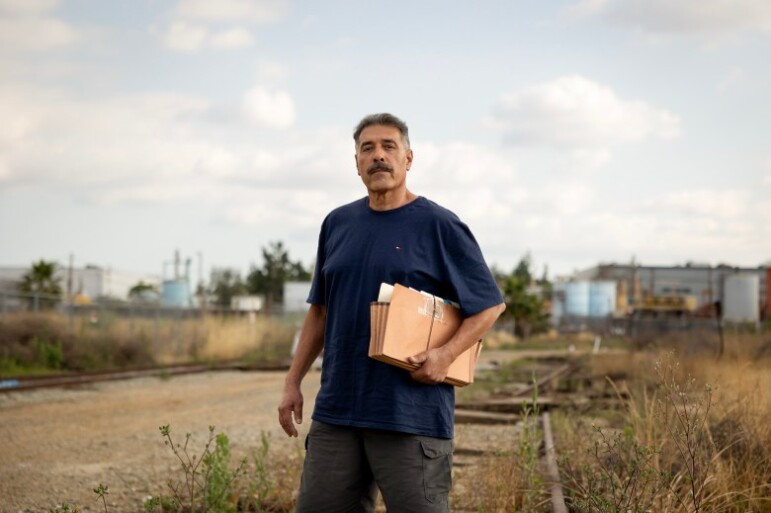
On a recent afternoon, several long-time Los Nietos residents gathered on Esther Rojo’s shaded patio to talk about the company. Sitting around a picnic table with instant coffee and pan dulce, talk often returned to the smells that come with living next to an industrial area – near hulking mystery tanks, rumbling tanker trucks and railroad cars.
Sometimes the odor that has wafted into yards and schools and bedrooms is chemical, like ammonia, and stings their throats when inhaled, they said. Sometimes, it’s like rotten eggs. It has come when kids are playing in the street on hot summer days. Parents call them inside where it becomes a game – running around, closing windows. The fortunate have air conditioners. The less fortunate sweat it out.
“Oftentimes the smells happen late in the evening or very, very early in the morning,” said Jaime Sanchez, 68, who has lived all his life in the community and is helping organize a loose collection of area residents calling themselves Neighbors Against Phibro-Tech.
Sanchez got involved in environmental activism around 2011. It was after Phibro-Tech pushed for an updated permit that would allow it to not only keep operating but also to start treating oily water in addition to the various chemicals already handled on site. His neighbor, Rojo, told him what was going on and he started attending community meetings.
“I was shocked and dismayed this was occurring in my own backyard,” Sanchez said.
State regulators ultimately didn’t finalize a draft permit at the time, effectively allowing Phibro-Tech to keep operating on the expired one as the law allows.
His census tract has more of a “pollution burden” than 97% of the state, according to California’s CalEnviroScreen. That’s a tool the state developed a decade ago to begin tracking issues of environmental justice.
Sanchez’ Los Nietos neighborhood has more asthma, cardiovascular disease, unemployment and “linguistic isolation” than the majority of California, according to the scoring system. It also has greater-than-average smog, fine particles, traffic and risk from lead paint. The neighborhood scores 100 out of 100 for proximity to hazardous waste.
It’s difficult, if not impossible, to blame the conditions – and certainly specific health problems – on any one company, environmental health experts say. Residents described mystery ailments, and can’t help but wonder if their industrial neighbors are to blame for what they experienced: asthma, itchy skin, rare liver cancer, a child with an autoimmune disease, a dog with seizures, dead birds.
Phibro-Tech hired consultants to conduct several health risk assessments over the years, which the company submitted to regulators. The most recent filed with the toxics department are from 2015 and analyzed both ongoing operations as well as historical contamination on site. State regulators ultimately approved the assessments, which found no “significant health risk” to workers and nearby residents, according to the agency’s online permitting information site.
Company officials said they’re often unfairly blamed for sounds and smells from other industrial sites. They’re quick to cite the example of a resident complaining about a giant tower that was actually across the street from Phibro-Tech.
“We said ‘That’s not us.’ And she said ‘Yes, it is,’” the company’s environmental attorney Zachary Walton recounted.
But regulators have documented pollution in the soil and groundwater under the site, including trichloroethylene (TCE) and hexavalent chromium, chemicals that have been linked to cancer. Advocates said the company has been slow to clean up contamination – putting the nearby community at risk and calling into question the company’s commitment to health and safety. The state toxics department cited Phibro-Tech in recent years for failing to finish remediating one contaminated area in a timely manner that it – and regulators – had known about for decades, records show. (The company did clean the area and toxics regulators are assessing the results, records and interviews show.)
Phibro-Tech officials defended the company’s record on pollution. They say the toxic material found in soil on site was from other companies or locations. Groundwater contamination is part of a plume from an old chemical company nearby that migrated across the area, they contend, adding that there’s no evidence the current operations are causing any environmental damage.
Several long-time residents of Los Nietos said they only drink bottled water, fearing contamination. The community’s drinking water, which doesn’t come from the groundwater basin beneath Phibro-Tech, meets state and federal standards for contaminants, according to water agency data. Nonetheless its drinking water scores high for contamination compared to most of the state, according to CalEnviroScreen.
“We completely understand the concerns by the community,” said David Thaete, the facility’s environmental health and safety manager. The company has cleaned up historical contamination on site and continues to regularly monitor groundwater and inspect equipment, he said. He added risk assessments “have demonstrated that the conditions of the plant are completely protective of both our workers and the surrounding community.”
But given the environmental risks in the area and the company’s history of regulatory violations, residents don’t understand how the Department of Toxic Substances Control could let Phibro-Tech keep operating. There are five schools within a mile of the company.
“The Department of Toxic Substances Control’s mandate is to protect the public. In reality they do not,” Jaime Sanchez said. “They’ve maintained the status quo.”
Officials have long tried to fix systemic permitting problems at the toxics agency, including the years-long delays.
In 2013 the department hired an outside consultant to review its permitting process. According to the consultant’s report, permit renewals averaged 4.3 years — and some took far longer. The report blamed staffing issues, a lack of standardized processes, unclear criteria for denial and poor management.
“As is readily apparent, there is a tension between monitoring existing facilities to ensure the protection of public health and the environment and ensuring that these existing facilities continue to operate so as to provide adequate capacity to prevent illegal disposal of hazardous waste,” according to the consultant’s report.
Among the concerns environmental groups raised to the report’s authors: lack of a clear standard for when to revoke or deny a permit. As a result, some companies limped along in a state of limbo.
Two years after that report, lawmakers crafted legislation to improve the permitting process and strengthen criteria for approval. The resulting law required that toxics regulators consider a company’s history of violations as well as environmental justice issues that a site’s operations might pose when deciding whether to renew a permit. The law required California to adopt regulations guiding how the Department of Toxic Substances Control would do that by the beginning of 2018.

But the agency has only partially complied with the law.
It created a scoring system to analyze companies’ past violations. A company with a certain number of serious violations – often those posing a significant threat to people or the environment – now needs to submit an audit and make changes as necessary. The most troubled risk being shut down. Phibro-Tech was required to submit an audit last year after posting one of the worst scores in the state.
But more than five years after the deadline, California still hasn’t adopted another major piece of the law: regulations for considering “cumulative impact” on communities in permitting decisions. That means there’s no requirement to look at just how much risk residents in a place like Los Nietos are already facing when the state is deciding whether to allow a hazardous waste site to keep operating.
“It’s been frustrating because it’s been years already,” said Grecia Orozco, staff attorney at the Center on Race, Poverty & the Environment, an environmental advocacy organization involved in crafting the 2015 legislation.
Why does it matter? Every single one of the 16 commercial treatment or disposal sites permitted to handle federally defined hazardous waste and that received such shipments last year abuts a community of color with a high rate of poverty, state shipping records and demographic data shows.
“They’re the ones bearing the brunt of these harms,” Orozco said.
The Department of Toxic Substances Control refused to be interviewed for this story, but did email responses to a list of written questions.
“We acknowledge that there are industrial facilities too close to homes and schools, and that historic decisions made by governments and private industry have resulted in disadvantaged communities bearing the brunt of environmental harms,” according to the agency’s prepared response. “This is not fair, and we as a State have a lot of work to do to untangle and repair the damage that has been done.”
Asked about the status of regulations to make a review of environmental justice-related factors a requirement, the agency said in its statement that it plans to have a virtual meeting this summer to get more feedback from stakeholders.
Still, the future of those regulations is unclear.
The Department of Toxic Substances Control is also in the midst of a legislatively mandated effort to craft a statewide hazardous waste management plan. Its July report, part of that process, acknowledged the requirement for regulators to consider factors including “cumulative impact” when deciding where to let hazardous waste sites operate.
“While these are important regulations, as protection of our most vulnerable communities is paramount, their potential impact on the number of permitted hazardous waste facilities is an important consideration for the Plan to further examine,” the report stated. Officials should also consider whether the additional safeguards are “justified,” according to the report.
Decision near for Phibro-Tech
Last summer, the Department of Toxic Substances Control released a draft of a new five-year permit for Phibro-Tech and solicited comments from the public.
“These new permit conditions would enhance protections and make them more enforceable,” according to a department statement.
Community and environmental activists met the proposal with heavy resistance. Earthjustice is now working with Neighbors Against Phibro-Tech to oppose the permit renewal.
Among the objections Earthjustice raised in its letter to state regulators were the pollution burden the low-income Latino community already faces, the company’s history of violations, the lack of a full environmental review for the new permit and that Phibro-Tech has been “very, very slow to address” soil and groundwater contamination on site.
The Los Angeles County Public Health Department also raised concerns, calling for more cleanup of contaminated soil at Phibro-Tech and more monitoring to ensure toxic chemicals don’t leave the site.
“Periodic monitoring for migration would provide crucial data to protect community health and safety,” according to a comment letter signed by Barbara Ferrer, the department’s director.
Phibro-Tech also submitted a letter to regulators. They asked for a 10-year permit, pointing out the agency recently approved new permits of that length for two facilities with an even worse record of violations than Phibro-Tech. “This establishes a precedent that requires a similar result for Phibro-Tech,” according to a letter signed by the facility’s health and safety manager, Thaete.
The toxics department expects to make a final permit decision in December. Given the history, many people expect further delays. And no matter the decision, an appeal seems likely.
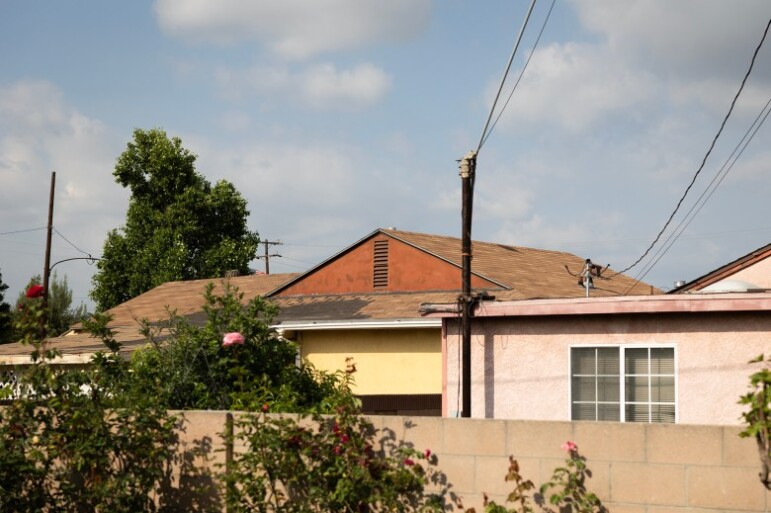
In the meantime, hazardous waste continues to arrive at Phibro-Tech. And Los Nietos residents continue to meet at the local library or in backyards to strategize ways to be heard.
“We will continue to fight and we will continue to challenge them,” said Jaime Sanchez, the local activist helping organize his neighbors.
He’s happy at least his adult daughter managed to get away from Phibro-Tech and has since moved to Hacienda Heights, a diverse community in unincorporated Los Angeles County.
But he learned recently that she now lives just four miles from another hazardous waste facility, the state’s last major recycler of old car batteries – Quemetco. That company has its own history of contamination and violating environmental regulations. The facility’s permit expired in 2015.
“It’s a reminder that the struggle for justice remains,” Sanchez said.
How we did it
By CalMatters Staff
CalMatters earlier this year investigated the large volume of hazardous waste California sends to its neighbors. Roughly half the toxic detritus generated in California crosses the border – often to states with weaker environmental regulations. Some advocates and officials decried the situation and called on California to handle more of its own waste.
We wanted to understand more about the infrastructure that exists in the state and whether it’s up to the task of handling more of this toxic burden. To do that we used the Department of Toxic Substances Control’s permitting and enforcement database – called Envirostor – to research permitted hazardous waste treatment, storage and disposal facilities. The database shows whether sites have expired permits, have documented contamination and if toxics regulators have found violations during inspections.
CalMatters also looked at shipping manifest data in a separate database called the Hazardous Waste Tracking System. The system shows the volume and type of waste permitted facilities receive. And we used a third tool, called CalEnviroScreen, that shows the pollution burden and demographic characteristics of census tracts around the state.
Combining the three tools, we were able to see where waste is going in the state, the safety concerns at those facilities, and the communities burdened with these operations.
We found the company with the oldest expired permit is close to getting a new one. To research the company, we read more than 1,000 pages of inspection reports and regulatory filings obtained from government databases and public records requests. We visited Los Nietos, the community neighboring Phibro-Tech, in June to talk to residents and toured the Santa Fe Springs facility and met with company representatives.
The numbers in the overall analysis are sure to change over time. Regulators are continuously updating the various databases – sometimes to correct errors. For example, during the course of reporting the number of permitted facilities dropped slightly and shipping data changed as new manifests were added to the system or corrected. Still, the analysis revealed that the state’s system for handling hazardous waste has a history of contamination and violations, and the communities most burdened typically have more people of color and a high percentage of residents living in poverty.
